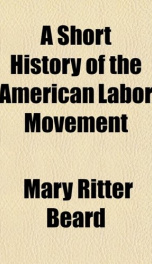a short history of the american labor movement

Purchase of this book includes free trial access to www.million-books.com where you can read more than a million books for free. This is an OCR edition with typos. Excerpt from book: CHAPTER III THE CENTURY-OLD TACTICS OF LABOR Labor tactics as important as labor organization. An organization without policy and action is, of course, powerless to accomplish results. Naturally, therefore, The early local associations of craftsmen had to decide just what methods they were to follow in dealing with their employers. In the old days when they worked side by side with the master, and there were only a few in the shop, it was a simple matter for them to talk over in a friendly way any problems or differences that arose. As the cities grew in size and the shops increased in number, as the employees began firmly to close their unions to masters, the question of how best to formulate their demands, present them to their employers, and enforce them became a live issue. One by one the elements of the problem were worked out and a program of tactics and policies developed. Collective" bargaining.Collective bargaining, meaning negotiations carried" on between employers (or their representatives), on the one hand, and the chosen representatives of the trade union, on theother hand, appeared in the early days of the American labor movement. It is recorded that the first attempt at regular collective bargaining of this kind was made by the Philadelphia shoemakers in 1799 when a "deputation fromTtEe society waited upon the employers with an offer of compromise." In this case the employers said they would consider the offer and appointed a committee of their own to meet with the journeymen. In 1802 the printers and shoemakers of Philadelphia and the shoemakers of Pittsburgh sent a committee to visit various employers and confer with them over the wage scales. In 1809, when the New York printers submitted theirlisls"tb the masters, this courteous reply came back from th...
Info about the book
Author:
Series:
Unknown
ISBN:
0195173252
Rating:
3.5/5 (4)Your rating:
0/5
Languge:
English
Users who have this book
Users who want this book
What readers are saying
What do you think? Write your own comment on this book!
write a commentif you like a short history of the american labor movement try:
Other books by this author
Do you want to read a book that interests you? It’s EASY!
Create an account and send a request for reading to other users on the Webpage of the book!



